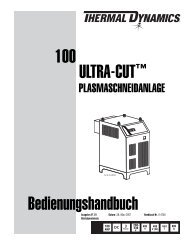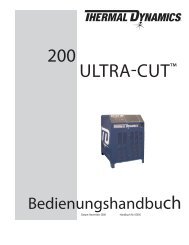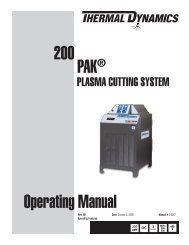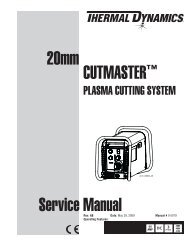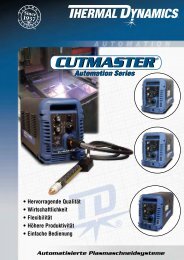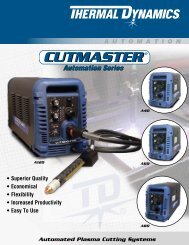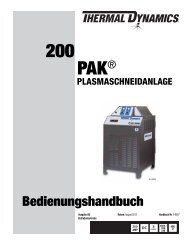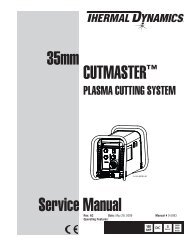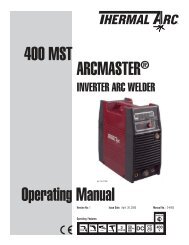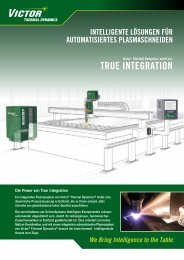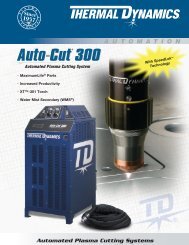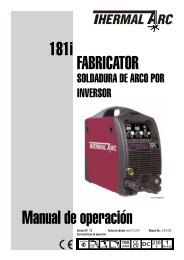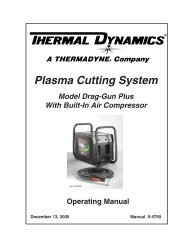211i Operating Manual FabricatOr® - Victor Technologies - Europe
211i Operating Manual FabricatOr® - Victor Technologies - Europe
211i Operating Manual FabricatOr® - Victor Technologies - Europe
You also want an ePaper? Increase the reach of your titles
YUMPU automatically turns print PDFs into web optimized ePapers that Google loves.
BASIC WELDING FABRICATOR <strong>211i</strong><br />
Distortion<br />
Distortion in some degree is present in all forms of welding. In many cases it is so small that it is barely<br />
perceptible, but in other cases allowance has to be made before welding commences for the distortion that will<br />
subsequently occur. The study of distortion is so complex that only a brief outline can be attempted hear.<br />
The Cause of Distortion<br />
Distortion is caused by:<br />
A. Contraction of Weld Metal:<br />
Molten steel shrinks approximately 11 per cent in volume on cooling to room temperature. This means<br />
that a cube of molten metal would contract approximately 2.2 per cent in each of its three dimensions. In<br />
a welded joint, the metal becomes attached to the side of the joint and cannot contract freely. Therefore,<br />
cooling causes the weld metal to flow plastically, that is, the weld itself has to stretch if it is to overcome<br />
the effect of shrinking volume and still be attached to the edge of the joint. If the restraint is very great,<br />
as, for example, in a heavy section of plate, the weld metal may crack. Even in cases where the weld<br />
metal does not crack, there will still remain stresses "Locked-up" in the structure. If the joint material is<br />
relatively weak, for example, a butt joint in 2.0mm sheet, the contracting weld metal may cause the sheet<br />
to become distorted.<br />
B. Expansion and Contraction of Parent Metal in the Fusion Zone:<br />
While welding is proceeding, a relatively small volume of the adjacent plate material is heated to a very<br />
high temperature and attempts to expand in all directions. It is able to do this freely at right angles to the<br />
surface of the plate (i.e., "through the weld", but when it attempts to expand "across the weld" or "along the<br />
weld", it meets considerable resistance, and to fulfil the desire for continued expansion, it has to deform<br />
plastically, that is, the metal adjacent to the weld is at a high temperature and hence rather soft, and, by<br />
expanding, pushes against the cooler, harder metal further away, and tends to bulge (or is "upset". When<br />
the weld area begins to cool, the "upset" metal attempts to contract as much as it expanded, but, because<br />
it has been "upset" it does not resume its former shape, and the contraction of the new shape exerts a<br />
strong pull on adjacent metal. Several things can then happen.<br />
The metal in the weld area is stretched (plastic deformation), the job may be pulled out of shape by the<br />
powerful contraction stresses (distortion), or the weld may crack, in any case, there will remain "lockedup"<br />
stresses in the job. Figures 4-29 and 4- 30 illustrate how distortion is created.<br />
Overcoming Distortion Effects<br />
Art # A-07705_AB<br />
Weld<br />
Hot Hot<br />
Upsetting<br />
Expansion with<br />
compression<br />
<strong>Manual</strong> 0-5225 4-17 BASIC WELDING GUIDE<br />
Cool<br />
Figure 4-29: Parent Metal Expansion<br />
Art # A-07706_AB<br />
Weld Permanent Upset<br />
Contraction<br />
with tension<br />
Figure 4-30: Parent Metal Contraction<br />
There are several methods of minimizing distortion effects.<br />
A. Peening<br />
This is done by hammering the weld while it is still hot. The weld metal is flattened slightly and because of<br />
this the tensile stresses are reduced a little. The effect of peening is relatively shallow, and is not advisable<br />
on the last layer.



